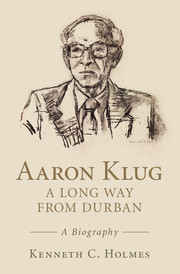It is unusual for a brilliant scientist to write a biography about another great scientist and even more unusual for the foreword to this wonderful biography to be written by yet another scientist who has known them both for almost fifty years. A fan of scientific biographies, I had read those of all my towering heroes of science including Max Perutz, Francis Crick, Fred Sanger and Sydney Brenner. These great scientists were all from the same Laboratory of Molecular Biology in Cambridge as Aaron Klug and indeed Ken Holmes. While these other biographies are beautifully written, they were not researched with the remarkable level of rigour demonstrated here by Ken Holmes. This biography of Sir Aaron Klug is so jam-packed with detailed observations that it serves to document not only the life and work of one great scientist, but indeed a period and place of unparalleled scientific discovery.
On a personal level, it revealed my many connections with Aaron Klug. Aaron and my father were both born in Lithuania. Aaron and my mother both grew up in Durban, South Africa. More generally, this book is not just a biography, it is encyclopaedic in its scope, serving to shed light on the history of some of the greatest discoveries including the structure of DNA, macromolecular crystallography, electron microscopy image reconstruction and more. And if this was not enough, the Appendix presents a crystal-clear easily approached introduction to diffraction, which continues to play a central and crucial role in the determination of the detailed structure of the tiny macromolecules that are at the heart of the secret of life.
Even better than the description of the science behind Klug’s work provided by Ken Holmes is what he reveals about such icons of British science as Rosalind Franklin, who was very close to both Aaron and Ken; Francis Crick, who closely followed Klug’s work on tRNA and chromatin; as well as Max Perutz, John Kendrew and Sydney Brenner, another South African, who also studied at Witwatersrand University in the 1940s and then subsequently came to England. Klug, Crick and Brenner really are for me the giants of twentieth-century science and they all played a huge role in my career.
Although Sydney Brenner holds the unique distinction of having been scientific father to more Nobel Laureates than any other Nobelist, with five other winners who worked with him, I worked most closely with Aaron Klug and Francis Crick. Their styles were very different. I remember joking that if you had a new idea and went to tell Francis about it, you left his office quite sure that the idea had indeed been his. On the other hand, if you had no new ideas and went to talk to Aaron, he helped a new idea germinate and you left his office quite sure that his new idea was yours. In either case, science as a whole benefited, but Aaron’s approach made people want to work for him. In this way, Aaron Klug brought out the best in others. His self-effacing manner, coupled to his reluctance to step in, made one feel empowered by what Holmes, in one humorous story, terms ‘one of Aaron’s endearing qualities: the ability to get someone else to take over onerous practical work by indicating a hesitancy that may be construed as a lack of competence’. In the context of scientific collaboration, it served to empower all those fortunate enough to work for him. The endorsers of this book also describe the influence of Aaron on collaborators and younger scientists. Klug was unique with his constructive ego-free approach to science.

